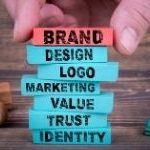What is a logo? It’s more than just a visual mark; it’s the cornerstone of your brand identity. A logo represents your brand’s personality, values, and purpose, serving as the face of your business to the world. In fact, studies reveal that 75% of consumers recognize a brand by its logo, underscoring the critical role it plays in shaping perception and loyalty.
In this complete guide, we’ll explore what a logo truly is, why it’s essential for your brand identity, and how to create a standout logo that sets your business apart. Whether you’re launching a new brand or revamping an existing one, this article will provide you with actionable insights to make your logo a powerful tool for success.
What Is a Logo?
At its core, a logo is a unique visual symbol or design that identifies your brand. It can include text, images, or a combination of both to convey your brand’s essence. Logos are not just about aesthetics; they’re about visual branding—creating a memorable identity that resonates with your audience.
Think of iconic logos like Nike’s swoosh or Apple’s bitten apple. These simple yet powerful designs go beyond visuals; they evoke emotions, inspire trust, and create lasting impressions. A logo is the starting point for building brand recognition and loyalty.
Why Is a Logo Important for Your Brand Identity?
First Impressions Matter
Your logo is often the first thing potential customers see when encountering your brand. Whether it’s on your website, business card, packaging, or social media, your logo acts as a visual representation of your company. A professional and eye-catching logo can instantly capture attention, make your brand memorable, and convey credibility. Conversely, a poorly designed logo can give the impression of unprofessionalism or lack of attention to detail.
It Builds Brand Recognition
Think about iconic brands like Apple, Nike, or McDonald’s—their logos are instantly recognizable and trigger an emotional response. A strong logo makes your brand easier to remember and identify in a crowded marketplace. Over time, it becomes a symbol that customers associate with your products or services, making it an essential tool for long-term brand recognition.
Sets You Apart from Competitors
In competitive markets, your logo helps you stand out. A unique and thoughtfully crafted logo can differentiate your brand and communicate what makes your business special. For example, it can convey your brand’s personality—whether it’s fun, innovative, professional, or luxurious—helping you attract the right audience and establish a distinct presence.
Communicates Your Brand’s Message and Values
Your logo visually represents your brand’s mission, values, and purpose. The colors, typography, and design elements of your logo can evoke emotions and communicate meaning without words. For instance:
- Green is often associated with growth or sustainability.
- Bold, modern typography can signal innovation.
- Traditional serif fonts might communicate trust and professionalism.
A carefully designed logo aligns your visual identity with your brand’s core values, ensuring that your message resonates with your audience.
Builds Trust and Professionalism
Consumers are more likely to trust a business with a polished and professional logo. A well-designed logo indicates that you’ve invested in your brand, which can make customers feel confident in your products or services. Trust is especially important for smaller businesses and startups trying to establish credibility in the eyes of their audience.
Drives Emotional Connection
Logos have the power to evoke emotions and foster a connection with your audience. A memorable logo becomes an integral part of how customers emotionally relate to your brand, turning them from one-time buyers into loyal advocates. For example, the iconic Coca-Cola logo stirs nostalgia and happiness for many, contributing to its long-standing brand loyalty.
Creates Consistency Across Platforms
In today’s digital world, your logo appears across a variety of platforms—your website, social media profiles, email signatures, product packaging, and more. A cohesive, recognizable logo helps maintain brand consistency across all touchpoints, reinforcing your identity in the minds of your customers.
For instance, brands like Coca-Cola or McDonald’s are instantly recognizable because their logos are deeply embedded in their brand identity.
Key Elements of a Great Logo
Creating a standout logo involves incorporating several key elements:
- Simplicity: A clean, simple design is easier to recognize and remember.
- Versatility: Your logo should work seamlessly across platforms, from business cards to billboards.
- Color Psychology: Use colors that evoke the emotions you want your audience to feel.
- Typography: Fonts should align with your brand’s tone and message.
- Scalability: Ensure your logo maintains clarity and quality, regardless of size or medium.
For example, Google’s logo relies on a simple sans-serif font and bold primary colors, making it versatile and timeless.
Types of Logos: Which Style Fits Your Brand?
Logos come in various styles, and choosing the right one depends on your brand’s personality:
- Wordmarks: These logos use typography alone (e.g., Google, Coca-Cola).
- Symbols: A visual icon represents the brand (e.g., Apple, Twitter).
- Combination Marks: Text and symbols work together (e.g., Adidas, Amazon).
- Abstract Logos: Unique shapes convey the brand’s essence (e.g., Pepsi).
- Emblems: Text is encased within a symbol or badge (e.g., Starbucks).
Selecting the right type ensures your logo aligns with your brand’s voice and target audience.
Steps to Create a Standout Logo
Follow these steps to design a logo that captures your brand’s essence:
- Step 1: Understand Your Brand
- Step 2: Research Competitors
- Step 3: Sketch Ideas
- Step 4: Choose Colors and Typography
- Step 5: Test for Scalability
- Step 6: Gather Feedback
- Step 7: Finalize and Save in Multiple Formats
- Step 8: Register Your Logo
Understand Your Brand
Before you even sketch a design, take time to understand your brand’s core identity.
- Define Your Mission: What does your brand stand for, and what values does it embody?
- Know Your Audience: Who are your ideal customers? Understanding their preferences and expectations can inform your design choices.
- Establish Your Brand Personality: Is your brand playful, professional, modern, or traditional? Your logo should reflect this personality.
- Clarify Your Unique Selling Proposition (USP): What sets your brand apart? Your logo should visually communicate this distinction.
Example: A tech startup might opt for a clean, minimalist design to convey innovation and modernity, while an organic food brand might use earthy tones and hand-drawn elements to highlight sustainability. To learn more about branding strategy, check out our guide on how to develop your brand organically.
Research Competitors
Analyze logos in your industry to identify trends, common elements, and gaps in the market.
- What Works: Look at successful brands and evaluate what makes their logos effective.
- What to Avoid: Identify overused design elements or clichés in your industry.
- Differentiate Yourself: Ensure your logo stands out while still aligning with industry expectations.
Pro Tip: Avoid copying competitors—your logo should be unique and reflect your brand’s individuality.
Brainstorm and Sketch Ideas
Creativity flows best when you allow yourself to explore freely.
- Start With Words: Write down keywords associated with your brand and its values.
- Sketch Rough Ideas: Don’t worry about perfection at this stage; focus on translating ideas into visual concepts.
- Experiment With Styles: Try different logo types (wordmarks, symbols, combination marks) to see which fits your brand best.
- Mind the Balance: Ensure your logo design doesn’t feel too crowded or overly simplistic.
Example: A coffee shop might experiment with a combination mark featuring a steaming cup and the shop’s name in bold typography.
Choose Colors and Typography
Your choice of colors and fonts can significantly influence how people perceive your brand.
- Colors:
- Use color psychology to convey your brand’s mood or message. For instance, blue suggests trust and professionalism, while red evokes passion and energy.
- Limit your palette to 2-3 complementary colors for simplicity and cohesion.
- Typography:
- Choose fonts that align with your brand’s tone. For example, a serif font exudes tradition and elegance, while a sans-serif font is modern and approachable.
- Ensure legibility, especially when your logo is resized or used in different contexts.
Pro Tip: Test your color palette and typography in grayscale to ensure your logo remains effective without color.
Test for Scalability and Versatility
A great logo works seamlessly across different platforms, sizes, and mediums.
- Scalability: Check how your logo looks when scaled up for billboards or down for business cards.
- Versatility: Ensure it works in multiple formats, such as digital (websites, apps) and physical (merchandise, signage).
- Monochrome Adaptation: Your logo should still look recognizable and impactful in black-and-white or single-color formats.
Example: The Nike swoosh is equally iconic on a large storefront as it is on a small shoe label.
Gather Feedback
Getting outside opinions can help refine your design.
- Internal Feedback: Share your logo with team members to ensure it aligns with your brand’s vision.
- Target Audience Testing: Show your logo to a focus group or a segment of your target audience to gauge their response.
- Iterate: Use constructive criticism to improve your design while staying true to your brand.
Pro Tip: Pay attention to feedback on first impressions—logos should be instantly memorable.
Finalize and Save in Multiple Formats
Once your logo design is complete, ensure it’s ready for various applications.
- Save in Vector Format: Formats like SVG or EPS maintain quality regardless of size.
- Export in Common Formats: Provide PNG, JPEG, and PDF versions for web, print, and sharing purposes.
- Create Variations: Include horizontal, vertical, and icon-only versions for flexibility.
Example: A tech company may need its logo in both a full-text version for a website header and a simplified icon version for a mobile app.
Protect Your Logo
Your logo is a valuable asset, so take steps to safeguard it:
- Trademark Registration: Secure legal protection to prevent others from copying your design.
- Create Brand Guidelines: Document how your logo should be used (e.g., minimum size, color variations, placement rules).
Common Logo Design Mistakes to Avoid
Avoid these pitfalls to ensure your logo strengthens your brand identity:
- Overcomplicating the Design: Simplicity ensures memorability.
- Following Trends Blindly: Prioritize timelessness over fleeting trends.
- Ignoring Scalability: Test your logo across different sizes and mediums.
- Using Low-Quality Graphics: A pixelated or blurry logo harms your credibility.
By steering clear of these mistakes, you can create a logo that stands the test of time.
Tools and Resources for Creating Logos
You don’t need to be a professional designer to create a stunning logo. If you’re just starting out, our AI logo generator can help you craft a high-quality design effortlessly. Additionally, here are some other tools you can use:
- Free Tools: Canva, Hatchful, Looka.
- Professional Software: Adobe Illustrator, CorelDRAW.
- Hire a Designer: Platforms like Fiverr or Upwork connect you with skilled logo designers.
Investing in the right resources ensures your logo reflects your brand’s quality and professionalism.
Real-Life Examples of Iconic Logos and Why They Work
Analyzing iconic logos can offer valuable insights:
- Nike’s Swoosh: Simple, dynamic, and reflective of motion and performance.
- Starbucks’ Mermaid: Unique, intricate, and tied to the brand’s origin story.
- FedEx’s Hidden Arrow: Clever use of negative space to symbolize speed and precision.
These logos succeed because they embody their brand’s story and values.
FAQs
How much does it cost to design a logo?
A logo can cost anywhere from $0 (DIY) to $10,000+ for professional design, depending on your needs and budget.
How long does it take to create a logo?
The timeline varies but typically ranges from a few days (DIY tools) to several weeks (custom design).
Should I hire a designer or use online tools?
It depends on your budget and desired quality. Online tools are budget-friendly, while professional designers offer tailored solutions.
Final Thoughts
A logo is more than just a design; it’s the heart of your brand identity. It communicates your values, builds trust, and makes your business memorable. By understanding what makes a logo effective and avoiding common mistakes, you can create a logo that elevates your brand and leaves a lasting impression.
Start your journey to creating a standout logo today—it’s an investment that will shape your brand’s future.












